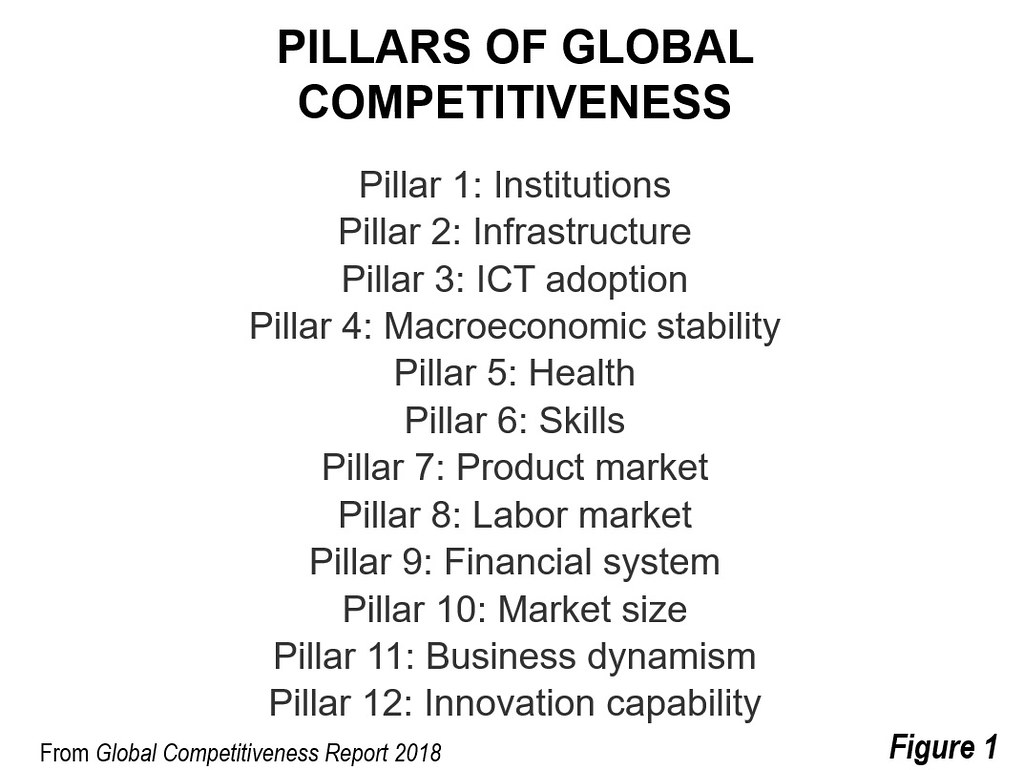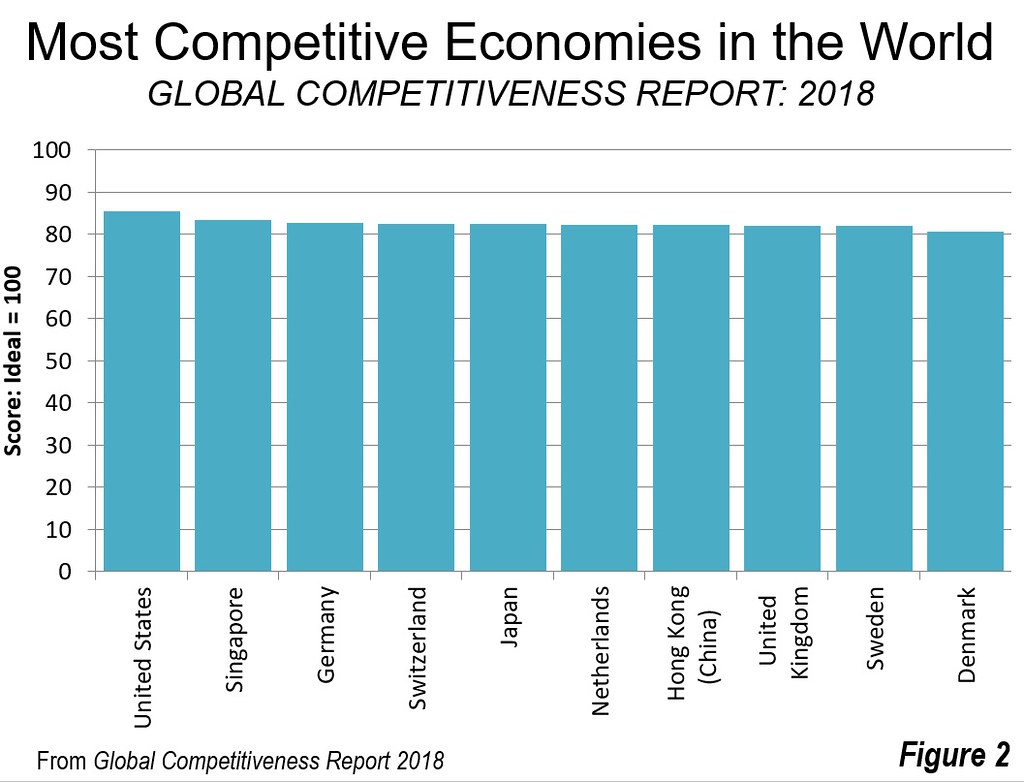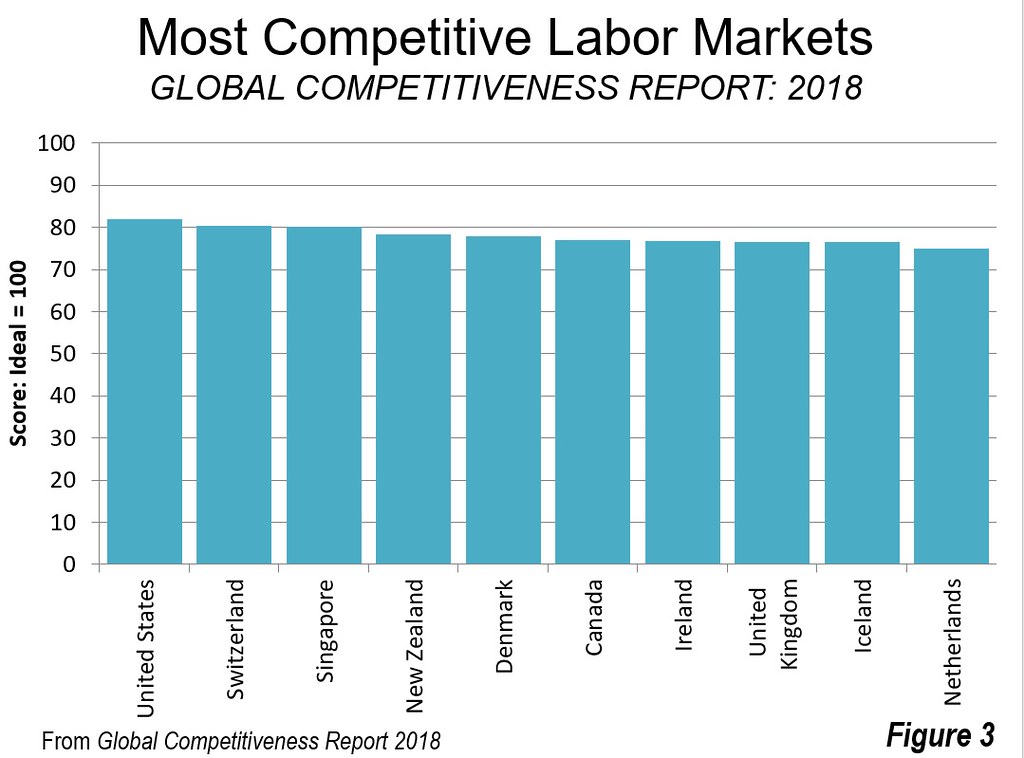The United States is rated as the world’s most competitive economy according to the Global Competitiveness Report 2018, which is published by the World Economic Forum (WEF). The World Economic Forum sponsors the well publicized and invitation only annual meeting at Davos, in the Swiss Alps each winter.
The Global Competitiveness Report ranks 140 world economies on 98 indicators, 54 of which are derived from actual data and 44 that are from the WEF’s Executive Opinion Survey. An overall score is calculated from the 98 indicators, which are classified in 12 Pillars (“subjects”), with overall scores reported for each indicator and each pillar. The 12 Pillars are described in detail here (Figure 1). The Report ranks economies based upon an ideal (the “competitiveness frontier”).

United States: The Global Competitiveness Report summarizes the United States as “the closest economy to the frontier, the ideal state, where a country would obtain the perfect score on every component of the index. With a competitiveness score of 85.6, it is 14 points away from the frontier mark of 100, implying that even the top-ranked economy among the 140 has room for improvement.”
The United States had topped the Global Competitiveness Report last in 2008 and has been rated as low as 7th since then. Last year’s report placed the US at second, though an analysis using this year’s revised methodology determined that the US would have ranked first last year as well. This year, the US leads in three of the 12 Pillars, Labor Market, Financial System, and Business Dynamism. The United States ranked third or better in 8 of the 12 Pillars.
Singapore: Singapore ranked second overall, with a score of 83.5, having typically placed either second or third in most years of the last decade. Singapore also led in three of the 12 Pillars, Infrastructure, Product Market, and Health (a four way tie). Singapore ranked third or better in 6 of the 12 Pillars. Singapore has developed a reputation for good government, something reaffirmed by its top rating in Public Sector Performance. Singapore also placed at the top in two indicators (within the “Institutions” pillar) that contribute disproportionately to wealth creation and business competitiveness, with the lowest “Burden of Government Regulation” and the highest rated “Efficiency of the Legal System in Settling Disputes.”
Germany: Germany’s 82.8 score earned a third placed rating, and improvement from 5th place last year. Germany ranked first in Innovation Capability, and Macroeconomic Stability (a 31 way tie). Germany ranked in the top three in four of the 12 Pillars.
Switzerland: Switzerland dropped to fourth place, after having ranked first every year since 2009. Switzerland’s drop of three places was the largest of any top 10 economy. Switzerland did not rank first in any of the 12 Pillars, but placed in the top three in four of the 12 Pillars.
Japan: In contrast, Japan experienced the largest improvement among the top ten, moving from 9th place last year to 5th place in 2018. Japan was rated in a four way tie for the top position in Health and is rated in the top three in the 12 Pillars.
Other Top Rated Economies: The balance of the top ten included (6) the Netherlands, (7) China’s Hong Kong (8) the United Kingdom (9) Sweden and (10) Denmark (Figure 2). Canada (12), Australia (14) and New Zealand (18) also scored well.

Other nations with large numbers of readers also did well. Consistent with its long-standing reputation for good government and corporate governance, New Zealand drew the top rating in the “Institutions” Pillar. Canada and Australia were among the 31 economies tied for top place in Macroeconomic Stability.
The balance of the article describes two of the “Pillars” that are particularly strong contributors to competitiveness, labor markets and infrastructure.
Labor Market Indicators
Flexible labor markets enable more competitive markets and generally result in lower product prices for consumers. Consistent with its top overall ranking, the United States captured the number one rank as Labor Market Pillar. Switzerland and Singapore, both ranked in the top four economies overall rank second and third in the Labor Market Pillar, followed by New Zealand and Denmark. Canada, Ireland, the United Kingdom, Iceland and the Netherlands round out the top 10 (Figure 3).

Infrastructure
There have been a number of public policy reports decrying the state of US transportation infrastructure. Yet, WEF rates US infrastructure well. Overall, the United States has the 9th best Infrastructure Pillar rating in the world (Figure 4). Within the category, the US ranks first in road connectivity, which is defined as “Average speed and straightness of a driving itinerary connecting the 10 or more largest cities that together account for at least 15 percent of the economy's total population.” An 11th ranking in “quality of roads” would be surprising based upon the frequent criticism US road conditions. The US is also in an 8 way tie in airport connectivity.

Singapore has the best overall Infrastructure Pillar ranking, followed by Hong Kong (China).
Competitiveness: Not a Zero-Sum Game
The Global Competitiveness Report is huge and this article can provide only highlights. Readers interested in further information can access the entire report (here), the ratings by indicator (here) and profiles of national economies (here). The World Economic Forum has designed what may be the most comprehensive international tool for assessing economic performance. Citizens of nations around the world would be well served by approaches that pay close attention to performance indicators and drivers, such as are highlighted in the Global Competitiveness Report. WEF suggests that the “goalpost for each indicator (100) … typically represents a policy target. Each country should aim to maximize its score on each indicator.” Further, WEF suggests an optimistic tone, that “This approach emphasizes that competitiveness is not a not a zero-sum game between countries—it is achievable for all countries.”
Wendell Cox is principal of Demographia, an international public policy and demographics firm. He is a Senior Fellow of the Center for Opportunity Urbanism (US), Senior Fellow for Housing Affordability and Municipal Policy for the Frontier Centre for Public Policy (Canada), and a member of the Board of Advisors of the Center for Demographics and Policy at Chapman University (California). He is co-author of the "Demographia International Housing Affordability Survey" and author of "Demographia World Urban Areas" and "War on the Dream: How Anti-Sprawl Policy Threatens the Quality of Life." He was appointed to three terms on the Los Angeles County Transportation Commission, where he served with the leading city and county leadership as the only non-elected member. He served as a visiting professor at the Conservatoire National des Arts et Metiers, a national university in Paris.
Photograph: Swiss Alps, by author.












